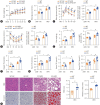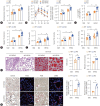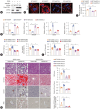USP29 alleviates the progression of MASLD by stabilizing ACSL5 through K48 deubiquitination
- PMID: 39355870
- PMCID: PMC11791544
- DOI: 10.3350/cmh.2024.0478
USP29 alleviates the progression of MASLD by stabilizing ACSL5 through K48 deubiquitination
Abstract
Background/aims: Metabolic dysfunction-associated steatotic liver disease (MASLD) is a chronic liver disease characterized by hepatic steatosis. Ubiquitin-specific protease 29 (USP29) plays pivotal roles in hepatic ischemiareperfusion injury and hepatocellular carcinoma, but its role in MASLD remains unexplored. Therefore, the aim of this study was to reveal the effects and underlying mechanisms of USP29 in MASLD progression.
Methods: USP29 expression was assessed in liver samples from MASLD patients and mice. The role and molecular mechanism of USP29 in MASLD were assessed in high-fat diet-fed and high-fat/high-cholesterol diet-fed mice and palmitic acid and oleic acid treated hepatocytes.
Results: USP29 protein levels were significantly reduced in mice and humans with MASLD. Hepatic steatosis, inflammation and fibrosis were significantly exacerbated by USP29 deletion and relieved by USP29 overexpression. Mechanistically, USP29 significantly activated the expression of genes related to fatty acid β-oxidation (FAO) under metabolic stimulation, directly interacted with long-chain acyl-CoA synthase 5 (ACSL5) and repressed ACSL5 degradation by increasing ACSL5 K48-linked deubiquitination. Moreover, the effect of USP29 on hepatocyte lipid accumulation and MASLD was dependent on ACSL5.
Conclusion: USP29 functions as a novel negative regulator of MASLD by stabilizing ACSL5 to promote FAO. The activation of the USP29-ACSL5 axis may represent a potential therapeutic strategy for MASLD.
Keywords: ACSL5 protein, human; Lipid metabolism disorders; Metabolic dysfunction-associtaed steatotic liver disease; USP29 protein, human.
Conflict of interest statement
The authors have no conflicts to disclose.
Figures









Similar articles
-
Stabilizing hepatic fatty acid oxidation: Editorial on "USP29 alleviates the progression of MASLD by stabilizing ACSL5 through K48 deubiquitination".Clin Mol Hepatol. 2025 Apr;31(2):592-595. doi: 10.3350/cmh.2024.0971. Epub 2024 Nov 6. Clin Mol Hepatol. 2025. PMID: 39501572 Free PMC article. No abstract available.
-
NORAD exacerbates metabolic dysfunction-associated steatotic liver disease development via the miR-511-3p/Rock2 axis and inhibits ubiquitin-mediated degradation of ROCK2.Metabolism. 2025 Mar;164:156111. doi: 10.1016/j.metabol.2024.156111. Epub 2024 Dec 20. Metabolism. 2025. PMID: 39710000
-
OTUB1 enhances fatty acid oxidation in APAP-induced liver injury by mediating ACSL5 deubiquitination.Biochem Pharmacol. 2025 Jul;237:116957. doi: 10.1016/j.bcp.2025.116957. Epub 2025 Apr 24. Biochem Pharmacol. 2025. PMID: 40280245
-
The emerging role of USP29 in cancer and other diseases.Cell Biochem Funct. 2024 Jan;42(1):e3928. doi: 10.1002/cbf.3928. Cell Biochem Funct. 2024. PMID: 38269503 Review.
-
The fatty acid omega hydroxylase genes (CYP4 family) in the progression of metabolic dysfunction-associated steatotic liver disease (MASLD): An RNA sequence database analysis and review.Biochem Pharmacol. 2024 Oct;228:116241. doi: 10.1016/j.bcp.2024.116241. Epub 2024 May 1. Biochem Pharmacol. 2024. PMID: 38697309 Free PMC article. Review.
Cited by
-
Stabilizing hepatic fatty acid oxidation: Editorial on "USP29 alleviates the progression of MASLD by stabilizing ACSL5 through K48 deubiquitination".Clin Mol Hepatol. 2025 Apr;31(2):592-595. doi: 10.3350/cmh.2024.0971. Epub 2024 Nov 6. Clin Mol Hepatol. 2025. PMID: 39501572 Free PMC article. No abstract available.
-
Association Between Visceral Adiposity and the Prediction of Hepatic Steatosis and Fibrosis in Patients with Metabolic Dysfunction-Associated Steatotic Liver Disease (MASLD).J Clin Med. 2025 May 13;14(10):3405. doi: 10.3390/jcm14103405. J Clin Med. 2025. PMID: 40429399 Free PMC article.
-
Metabolic-Dysfunction-Associated Steatotic Liver Disease: Molecular Mechanisms, Clinical Implications, and Emerging Therapeutic Strategies.Int J Mol Sci. 2025 Mar 25;26(7):2959. doi: 10.3390/ijms26072959. Int J Mol Sci. 2025. PMID: 40243565 Free PMC article. Review.
-
ELAVL1-mediated USP29 mRNA degradation activates TAK1 driving M1 microglial polarization and neural stem cell differentiation dysregulation in spinal cord injury.Cell Death Discov. 2025 Jul 9;11(1):317. doi: 10.1038/s41420-025-02604-8. Cell Death Discov. 2025. PMID: 40634288 Free PMC article.
-
Pemafibrate Ameliorates Steatotic Liver Disease Regardless of Endothelial Dysfunction in Mice.Antioxidants (Basel). 2025 Jul 20;14(7):891. doi: 10.3390/antiox14070891. Antioxidants (Basel). 2025. PMID: 40722995 Free PMC article.
References
-
- Younossi Z, Anstee QM, Marietti M, Hardy T, Henry L, Eslam M, et ak. Global burden of NAFLD and NASH: trends, predictions, risk factors and prevention. Nat Rev Gastroenterol Hepatol. 2018;15:11–20. - PubMed
-
- Powell EE, Wong VW, Rinella M. Non-alcoholic fatty liver disease. Lancet. 2021;397:2212–2224. - PubMed
-
- European Association for the Study of the Liver. European Association for the Study of Diabetes. European Association for the Study of Obesity EASL-EASD-EASO clinical practice guidelines on the management of metabolic dysfunction-associated steatotic liver disease (MASLD): executive summary. Diabetologia. 2024;67:2375–2392. - PMC - PubMed
-
- Riazi K, Azhari H, Charette JH, Underwood FE, King JA, Afshar EE, et al. The prevalence and incidence of NAFLD worldwide: a systematic review and meta-analysis. Lancet Gastroenterol Hepatol. 2022;7:851–861. - PubMed
-
- Yong JN, Lim WH, Ng CH, Tan DJH, Xiao J, Tay PWL, et al. Outcomes of nonalcoholic steatohepatitis after liver transplantation: an updated meta-analysis and systematic review. Clin Gastroenterol Hepatol. 2023;21:45–54.e6. - PubMed
MeSH terms
Substances
Grants and funding
- 81970011/National Science Foundation of China
- 82170595/National Science Foundation of China
- ZNLH202211/Basic Medicine-Clinical Medicine Transformation Collaborative Fund of Zhongnan Hospital of Wuhan University
- ZNLH202204/Basic Medicine-Clinical Medicine Transformation Collaborative Fund of Zhongnan Hospital of Wuhan University
- GDXZ2020006/Henan Charity Federation Hepatobiliary Fund
LinkOut - more resources
Full Text Sources
Research Materials

